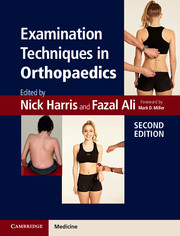Book contents
- Frontmatter
- Dedication
- Contents
- List of contributors
- Foreword
- Preface
- Acknowledgements
- 1 General principles of orthopaedic clinical examination
- 2 Examination of the shoulder
- 3 Examination of the elbow
- 4 Examination of the wrist
- 5 Examination of the hand
- 6 Examination of the peripheral nerves in the hand and upper limb
- 7 Examination of the adult spine
- 8 Examination of the hip
- 9 Examination of the knee
- 10 Examination of the foot and ankle
- 11 Examination of the brachial plexus
- 12 Orthopaedic examination techniques in children
- 13 Examination of the spine in childhood
- Index
- References
5 - Examination of the hand
- Frontmatter
- Dedication
- Contents
- List of contributors
- Foreword
- Preface
- Acknowledgements
- 1 General principles of orthopaedic clinical examination
- 2 Examination of the shoulder
- 3 Examination of the elbow
- 4 Examination of the wrist
- 5 Examination of the hand
- 6 Examination of the peripheral nerves in the hand and upper limb
- 7 Examination of the adult spine
- 8 Examination of the hip
- 9 Examination of the knee
- 10 Examination of the foot and ankle
- 11 Examination of the brachial plexus
- 12 Orthopaedic examination techniques in children
- 13 Examination of the spine in childhood
- Index
- References
Summary
Examination of a patient’s hand should always follow a comprehensive history. This provides valuable information to determine a diagnosis and to assess the impact that symptoms have on the patient’s daily functions. Always remember to ask for hand dominance, occupation and recreational activities.
The following hand examination can confirm the working diagnosis or may raise possible alternative diagnoses. It may be used to assess a patient’s hand function. Observations made from the history and examination may have an impact on the treatment options available.
There are numerous pathologies in the hand, which makes a standard approach helpful. By looking, feeling and assessing movement we can be sure of picking up most of the significant clinical findings. Special tests for individual pathologies may then complete the examination.
Screening
After exposing the upper limb adequately a screening examination is performed. Screening is an extremely important part of the examination, as close inspection whilst this is carried out will reveal clues to virtually all pathologies in the hand.
- Type
- Chapter
- Information
- Examination Techniques in Orthopaedics , pp. 53 - 72Publisher: Cambridge University PressPrint publication year: 2014

